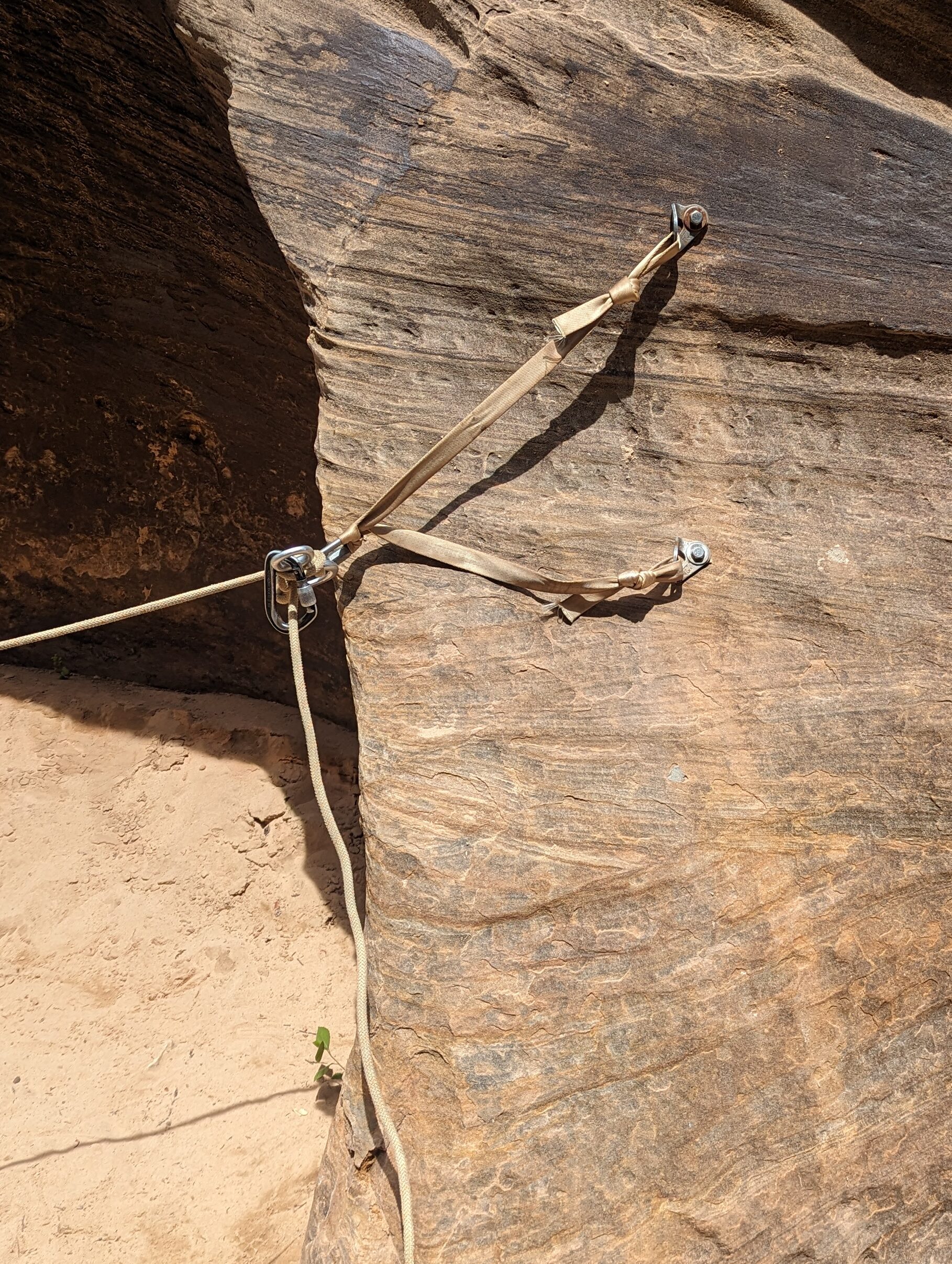This is what I left at the first rappel in Zion’s Pine Creek. I wish I had taken a before photo, now I can’t remember why I decided to change it. I think it was a loop of webbing off a single bolt.

Instead of replacing the small scrap of webbing and installing a more standard interface, I decided to see if I could make do with the supplies at hand. Some things to consider:
Bolts and Hangers
In most Southwest canyoneering, bolts are uncommon, and will usually be removed by purist canyoneers, regardless of the quality of hardware or how well placed they are. Zion is somewhat unique in this regard, with many of the trade route canyons having established and even occasionally maintained bolt stations.
The rock they’re installed in seemed solid enough, without obvious cracks or flakes. Both appear to be sleeve bolts. Rust staining suggests something there may not be stainless steel.
Neither of the hangers spun, both were snug against the rock. They were not ideally oriented for the direction of pull.
While these bolts and hangers seemed more than adequate, when I notice things like non stainless hardware, and suboptimal orientations, I wonder if the installer may have made other less than ideal choices.
Webbing
The webbing was supple, and showed no signs of serious abrasion or UV damage. I acknowledge the possibility the webbing came from a substandard manufacturer, or may have been exposed to chemicals or loads high enough to weaken it to an unsafe state. I was comfortable rolling those dice.
Attaching the webbing to the hangers by an overhand follow through is a little unusual. This results in a theoretical strength of 2640 pounds per leg, instead of 4000.
In an ideal world, I would have installed screw links on those hangers, so the webbing wasn’t in direct contact with a sharp edge. Unfortunately some canyoneers are really cheap, and would poach the screw links unless they were installed with red thread lock and a wrench. Also, I’m not in the mood to donate three screw links per pitch per canyon.
An aside, I knew a couple canyoneers who if they found a rated, certified screw link at a pitch, they’d keep it for when they really needed it, and replace it with a rated, uncertified link from a hardware store. I’m not sure what sort of pitch would have been worthy of a rated AND certified link.
(Interestingly, later in Pine Creek, I saw where it looked like links worn by rope pulls had been used as an interface between webbing and bolt hangers)



Screw Link
The screw link was rated, certified, and manufactured by Maillon-Rapide. Zero complaints there. Girth hitching it to the webbing is unusual. I wish I had used a clove hitch, I feel like it would have been more stylish. In either case, especially with the girth hitch, I’m not sure how much potential there is for slippage.
For example, I’ve seen some climbers claim a girth hitched master point is redundant, but I’m not sure how much a believe them, especially on Dyneema.
Either way, if the webbing in the hitch itself were to fail at any point, the link would not stay attached.
Rigging
We used an 8 Block for rigging. This allows for easy conversion to lower, should someone on rope be injured, incapacitated, or out of rope.
Using a block like this presents the opportunity for a user to attempt to rappel off the wrong side. This risk can be mitigated in several ways, but that’s another post.
It was safe, it worked, and it was so efficient we ended up stuck behind a slow group for the rest of the day.

Leave a Reply